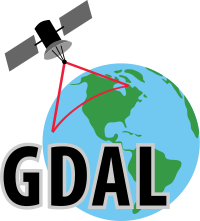GDAL
From Wikipedia, the free encyclopedia
 |
|
| Developed by | Open Source Geospatial Foundation |
|---|---|
| Latest release | 1.6.0 / 2008-12-10 |
| Operating system | Cross-platform |
| Type | Library |
| License | X/MIT |
| Website | GDAL/OGR homepage |
GDAL (Geospatial Data Abstraction Library) is a library for reading and writing raster geospatial data formats, and is released under an X/MIT style Open Source license by the Open Source Geospatial Foundation. As a library, it presents a single abstract data model to the calling application for all supported formats. It may also be built with a variety of useful command-line utilities for data translation and processing.
The related OGR library (which is part of the GDAL source tree) provides a similar capability for simple features vector data.
GDAL was primarily developed by Frank Warmerdam until the release of version 1.3.2, when maintainership was officially transferred to the GDAL/OGR Project Management Committee under the Open Source Geospatial Foundation.
GDAL/OGR is considered a major project in the Open Source and also in the commercial GIS community due to its widespread use and comprehensive set of functionalities. In the words of Howard Butler "I see GDAL as the glibc/glibc++ of the geospatial software world. It's open, it provides core functionality, I can't understand how anybody gets anything done without it."
[edit] Software that uses GDAL/OGR
Several software programs use the GDAL/OGR libraries to allow them to read and write multiple GIS formats. Such programs include:
- Delta3D
- GRASS GIS
- OSSIM
- GvSIG
- Quantum GIS
- FWTools – a cross-platform open source GIS software bundle compiled by Frank Warmerdam
- MapServer
- Google Earth - A virtual globe and world imaging program.
- OpenEV
- gdaltokmz, a Python module translating from GDAL-supported raster graphics formats to the Google Earth KMZ format
- ArcGIS 9.2 can use GDAL for customized raster formats[1]
- TopoQuest - Internet topographic map viewer
- Orfeo toolbox - A satellite image processing library
[edit] References
- Schuyler Erle, Rich Gibson and Jo Walsh (2005). Mapping Hacks. O'Reilly. ISBN 0-596-00703-5.
- Tyler Mitchell (2005). Web Mapping Illustrated. O'Reilly. ISBN 0-596-00865-1.
- ^ "ArcGIS 9.2 Desktop Help: Supported raster dataset file formats". ESRI. 2007-08-15. http://webhelp.esri.com/arcgisdesktop/9.2/body.cfm?tocVisable=1&ID=2458&TopicName=Supported%20raster%20dataset%20file%20formats.

